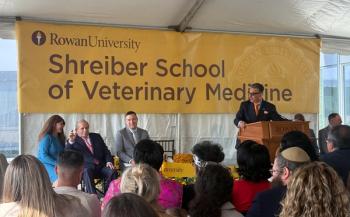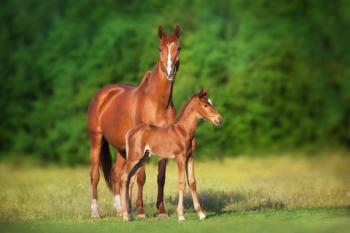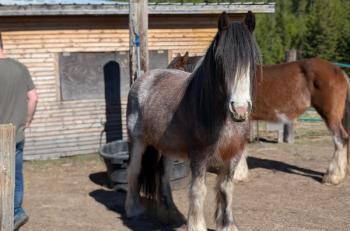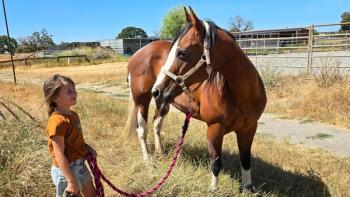
The story of a survivor: Q's will to live
Thanks to the persistence and care of his veterinarian, one young foal battled EPE and won.
As a 6-month-old foal living at Rosebud River Ranch in Snoqualmie, Wash., Q was very quiet and somewhat lethargic. He wasn’t growing as much as he should. His coat was scruffy, similar to a foal that was a little “wormy,” and he had low-grade fevers. When he was about 11 months old, he spiked a fever of 104 F (40) and became severely depressed and completely anorexic. It was then that a veterinarian examined him.
Prior to treatment, a sick Q had a scruffy coat and was lethargic and underweight. (All photos courtesy of Dr. Chantal Rothschild.)
The veterinarian did some blood work and noticed that the foal’s serum albumin concentration was very low, though he couldn’t explain why. He treated him for a suspected viral or bacterial infection, giving him flunixin meglumine, sulfonamide antibiotics, and fluids but was still puzzled about a definitive diagnosis. When Q’s condition continued to deteriorate, he was referred to Chantal Rothschild, DVM, DACVIM, at Northwest Equine Veterinary Associates in Maple Valley, Wash.
“Clinically, he was slightly small for his age,” Rothschild notes. “He was febrile and very lethargic. He wouldn’t eat, his coat was scruffy and he exhibited ventral edema.” Putting the history together, Rothschild realized the foal had been sick for several months.
His blood work, though, was somewhat unremarkable for how sick he was. Laboratory results showed a mildly increased white blood cell count, hypoproteinemia and low serum albumin. An ultrasound exam of his chest and abdomen was done in an effort to determine what kind of infection was involved. Rothschild submitted several other tests, including assays for serum M protein and fecal occult blood to rule out other diseases, but now equine proliferative enteropathy (EPE) caused by Lawsonia intracellularis was the main suspicion.
Rothschild submitted a fecal sample for PCR detection of L. intracellularis DNA and the test came back negative. (Fecal PCR results tend to be positive at the beginning of the disease, when the microbial organism is actively replicating in the intestinal epithelial cells, but the duration of Q’s illness likely led to a negative PCR result.) However, with his serum protein concentration dropping very quickly, his condition deteriorating and the edema under his jaw worsening, there wasn’t much time to wait for further results.
With the signs noted, Rothschild decided to treat him for EPE, a disease common in swine but not commonly seen in horses in the Pacific Northwest, though prevalent in other states. If it was L. intracellularis, he was going to respond, and if it wasn’t, he was probably going to die due to his condition.
Rothschild put Q on a regimen of azithromycin, rifampin, omeprazole, sucralfate and flunixin meglumine to lower the fever and make him feel better. She also provided supportive therapy; Q was hydrated and tubed with water, electrolytes and mineral oil since he wasn’t defecating during the time he was feverish and anorexic.
“Within two days of the antibiotic treatment he responded,” Rothschild says. “His fever decreased, his albumin levels stopped dropping and within a few additional days, his rectal temperature was normal. He even started eating again.” Q remained on the antibiotics for six additional weeks but no longer needed the supportive care since his condition had improved.
At the end of treatment, Q showed significant improvement.
No pigs were ever present at Rosebud River Ranch. It was possible that either rabbits or deer were the source for Q’s L. intracellularis infection, since both were fairly prevalent on the property and known sources for spreading the organism. Q was the only foal on the property and since L. intracellularis predominantly affects weanlings, no other horses were affected. In Q’s case, stress might have also been an exacerbating factor, since he had recently traveled for castration and hernia repair surgery and may have had a compromised immune system.
Since his recovery, Q has done very well. “He’s six inches taller, his coat is really silky and he’s strong and active,” states Rothschild. “He went back to the horse he should have been.”
Q with Dr. Chantal Rothschild after treatment.
Rothschild recognizes that there are some patients that just really want to live—and Q was one of them. “He never gave up even though his condition was quite severe and his disease quite advanced,” she continues. “He just wanted to get better.”
Visit
Newsletter
From exam room tips to practice management insights, get trusted veterinary news delivered straight to your inbox—subscribe to dvm360.






